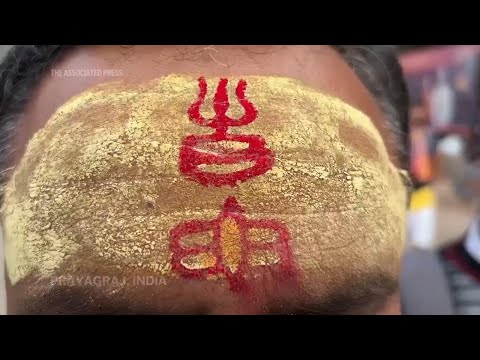(31 Jan 2025)
RESTRICTION SUMMARY:
ASSOCIATED PRESS
Prayagraj, India – 14 January 2025
1. Tilt up of a priest applying a religious marking on a man’s forehead
2. Various of people walking back after bathing with religious markings on their forehead
3. Close of a religious marking on a man’s forehead
4. SOUNDBITE (Hindi) Anuj Kumar Tiwari, 21, priest:
++SOUNDBITE IS OVERLAID BY SHOT 5++
"By applying sandalwood, the sins of the body are destroyed. It keeps the mind cool, that is why sandalwood is applied."
5. Pan of people with their foreheads with religious markings
6. Mid of a priest applying religious marking on a woman’s forehead
7. Close of religious marking on Chauhan’s family member reading (Hindi) “Radhe (Hindu goddess)
8. SOUNDBITE (Hindi) Sushila Chauhan, Pilgrim:
++SOUNDBITE STARTS ON PREVIOUS SHOT AND IS OVERLAID BY SHOT 9++
“I put the tilak (religious mark) because it gives you concentration, peace of mind and mind is satisfied. If anyone tries to commit a mistake, then what happens is that we feel that we should not do anything wrong. We always have to cooperate and help others and we have to protect the Sanatana dharma.”
9.Various of people and holy men heading towards bathing in a procession, crowd gathered watching
10. Pan of people bathing
11. Mid of a man bathing
STORYLINE:
The pilgrims come and go as strangers. They march like a sea of people, walking toward the spot where they take holy baths, drawn by the hope that the bathing would bring them salvation.
But when they leave — believing their sins have been cleansed by the redemptive bath — they leave with one thing in common: their foreheads display a sacred stroke of color.
This sacred stroke, called tilak, is ubiquitous to the millions of Hindu pilgrims attending the Maha Kumbh festival in India’s northern Prayagraj city, where faithful gather at the spot where the Ganges, the Yamuna and the mythical Saraswati rivers converge.
Applied by Hindu priests using sandalwood paste, turmeric and sacred ashes, these strokes represent divine connections in Hinduism, with each type having its own symbolic association with a deity.
The festival, where a stampede killed 30 people Wednesday, has historically embraced diversity in the ancient traditions of Hinduism.
They allow plurality in belief and ritual practice of faith of Hindus, who comprise 80% of India’s population.
The markings worn on the foreheads cut across castes and classes, many of them being unique identifiers of the numerous religious communities, all under the umbrella of Hinduism.
Hundreds of Hindu priests at the festival paint them on the foreheads of the pilgrims.
Many consider it a selfless service to their religion — without which the pilgrimage is incomplete.
A vermilion dot on the forehead is one of India’s most widely accepted Hindu cultural insignias.
But at the festival, where millions are flocking to pray and bathe at the confluence of India’s holy rivers, it morphs into a major display of Hinduism in various forms and designs.
Some pilgrims wear it in the form of three yellow horizontal lines.
Others prefer two vertical white ones with a red or yellow stripe in the center.
Then there is the large red vertical mark, or names of various Hindu gods written in Hindi and English.
The Maha Kumbh festival began on January 13 and continues over six weeks.
About 400 million people — most of them from the country’s vast rural and remote locations — were expected to attend the festival where Hindu faith and spirituality reigns supreme.
Find out more about AP Archive: http://www.aparchive.com/HowWeWork
Twitter: https://twitter.com/AP_Archive
Facebook: https://www.facebook.com/APArchives
Instagram: https://www.instagram.com/APNews/
You can license this story through AP Archive: http://www.aparchive.com/metadata/youtube/e3b197a46fd746e580e02f80e3725d85
Author: AP Archive
Go to Source
News post in February 5, 2025, 6:04 am.
Visit Our Sponsor’s:
News Post In – News





